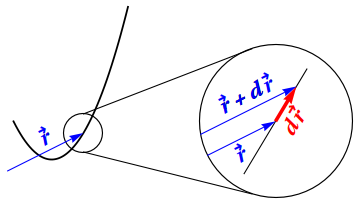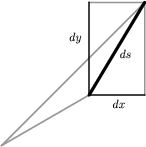The Vector Differential, $d\rr$
 Figure 7: The infinitesimal displacement vector $d\rr$ along a curve, shown in an
“infinite magnifying glass”. In this and subsequent figures, artistic
license has been taken in the overall scale and the location of the origin
in order to make a pedagogical point.
Figure 7: The infinitesimal displacement vector $d\rr$ along a curve, shown in an
“infinite magnifying glass”. In this and subsequent figures, artistic
license has been taken in the overall scale and the location of the origin
in order to make a pedagogical point.
The position vector \begin{equation} \rr=x\,\xhat+y\,\yhat+z\,\zhat \end{equation} describes the location of the point $(x,y,z)$ in rectangular coordinates, and is usually thought of as pointing from the origin to that point. It is instructive to draw a picture of the small change $\Delta\rr=\Delta x\,\xhat + \Delta y\,\yhat + \Delta z\,\zhat$ in the position vector between nearby points. Try it! This picture is so useful that we will go one step further, and consider an infinitesimal change in position. Instead of $\Delta\rr$, we will write $d\rr$ for the vector between two points which are infinitesimally close together. This is illustrated in Figure 7, which shows a view of the curve through an “infinite magnifying glass”.
Like any vector, $d\rr$ can be expanded with respect to $\xhat$, $\yhat$, $\zhat$; the components of $d\rr$ are just the infinitesimal changes $dx$, $dy$, $dz$, in the $x$, $y$, and $z$ directions, respectively, that is \begin{equation} d\rr = dx\,\xhat + dy\,\yhat + dz\,\zhat \label{drdef} \end{equation} as shown in Figure 8a. The geometric notion of $d\rr$ as an infinitesimal vector displacement will be a unifying theme to help us in visualizing the geometry of all of vector calculus.
What is the infinitesimal distance $ds$ between nearby points? Just the length of $d\rr$. We have \begin{equation} ds = |d\rr| = \sqrt{d\rr\cdot d\rr} = \sqrt{dx^2 + dy^2 + dz^2} \label{dsdef} \end{equation}
and squaring both sides leads to \begin{equation} ds^2 = |d\rr|^2 = d\rr\cdot d\rr = dx^2 + dy^2 + dz^2 \label{ds1} \end{equation} which is just the infinitesimal Pythagorean Theorem, the two-dimensional version of which is shown in Figure 8b. 1)

